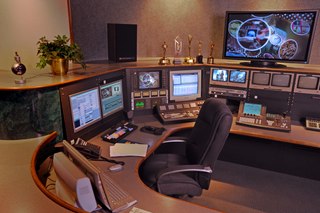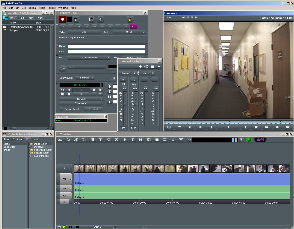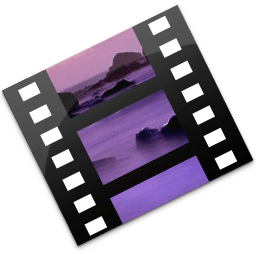
DV is a family of codecs and tape formats used for storing digital video, launched in 1995 by a consortium of video camera manufacturers led by Sony and Panasonic. It includes the recording or cassette formats DV, MiniDV, DVCAM, Digital8, HDV, DVCPro, DVCPro50 and DVCProHD. DV has been used primarily for video recording with camcorders in the amateur and professional sectors.

Non-linear editing is a form of offline editing for audio, video, and image editing. In offline editing, the original content is not modified in the course of editing. In non-linear editing, edits are specified and modified by specialized software. A pointer-based playlist, effectively an edit decision list (EDL), for video and audio, or a directed acyclic graph for still images, is used to keep track of edits. Each time the edited audio, video, or image is rendered, played back, or accessed, it is reconstructed from the original source and the specified editing steps. Although this process is more computationally intensive than directly modifying the original content, changing the edits themselves can be almost instantaneous, and it prevents further generation loss as the audio, video, or image is edited.

iMovie is a free video editing application made by Apple for the Mac, the iPhone, and the iPad. It includes a range of video effects and tools like color correction and image stabilization, but is designed to be accessible to users with little or no video editing experience. iMovie's professional equivalent is Apple's Final Cut Pro X.

A digital audio workstation is an electronic device or application software used for recording, editing and producing audio files. DAWs come in a wide variety of configurations from a single software program on a laptop, to an integrated stand-alone unit, all the way to a highly complex configuration of numerous components controlled by a central computer. Regardless of configuration, modern DAWs have a central interface that allows the user to alter and mix multiple recordings and tracks into a final produced piece.
In video technology, 24p refers to a video format that operates at 24 frames per second frame rate with progressive scanning. Originally, 24p was used in the non-linear editing of film-originated material. Today, 24p formats are being increasingly used for aesthetic reasons in image acquisition, delivering film-like motion characteristics. Some vendors advertise 24p products as a cheaper alternative to film acquisition.

Windows Movie Maker is a discontinued video editing software program by Microsoft. It was first included in Windows Me on September 14, 2000, and in Windows XP on October 25, 2001. It later became a part of the Windows Essentials software suite, and offered the ability to create and edit videos as well as to publish them on OneDrive, Facebook, Vimeo, YouTube, Windows Live Groups, and Flickr. It is comparable to Apple's iMovie.

Vegas Pro is a Professional video editing software package for non-linear editing (NLE). The first release of Vegas Beta was on 11 June 1999. The software runs on the Windows operating system.
Final Cut Express was a video editing software suite created by Apple Inc. It was the consumer version of Final Cut Pro and was designed for advanced editing of digital video as well as high-definition video, which was used by many amateur and professional videographers. Final Cut Express was considered a step above iMovie in terms of capabilities, but a step underneath Final Cut Pro and its suite of applications. As of June 21, 2011, Final Cut Express was discontinued in favor of Final Cut Pro X.

LiVES (LiVES Editing System) is a free and open-source video editing software and VJ tool, released under the GNU General Public License version 3 or later. There are binary versions available for most popular Linux distributions (including Debian, Ubuntu, Fedora, Suse, Gentoo, Slackware, Arch Linux, Mandriva and Mageia). There are also ports for BSD, and it will run under Solaris and IRIX. It has been compiled under OS X Leopard, but not thoroughly tested on that platform. In early 2019, a version for Microsoft Windows was announced, with a release slated for in the second half of 2019.

Avid Free DV is a non-linear editing video editing software application which was made by Avid Technology. Avid discontinued this product, stating: "Effective September 1, 2007, Avid is discontinuing the Avid Free DV application offer, and has no immediate plans to make an updated version available."

Avid Media Composer is a video editing application or non-linear editing system (NLE) developed by Avid Technology. Initially released in 1989 as an offline editing system on the Macintosh II, the application has since evolved to allow offline and online editing workflows, including up to 16K editing and finishing. Since the 1990s, Media Composer has been the dominant non-linear editing system in the film and television industry.

DrawPlus is a 2D vector graphics editor and animation software developed by the UK-based software company Serif, also responsible for PhotoPlus, PagePlus, WebPlus, Digital Scrapbook Artist, Affinity Designer, Affinity Photo and other titles.

Corel VideoStudio is a video editing software package for Microsoft Windows.
VEGAS Movie Studio was a consumer-based nonlinear video editor designed for the PC. It was a scaled-down version of Vegas Pro. It was developed by Sony for its first 13 versions. It was sold in Sony's larger 2016 sale of much of its creative software suite to Magix, who developed Versions 14 to 17. Magix would later discontinue VEGAS Movie Studio in 2021, in favor of the unrelated Magix Movie Studio.
Clesh is a cloud-based video editing platform designed for the consumers, prosumers, and online communities to integrate user-generated content. The core technology is based on FORscene which is geared towards professionals working for example in broadcasting, news media, post production.
Serif have a range of software products, which are listed below.
EditDV was a video editing software released by Radius, Inc. in late 1997 as an evolution of their earlier Radius Edit product. EditDV was one of the first products providing professional-quality editing of the then new DV format at a relatively affordable cost and was named "The Best Video Tool of 1998". Originally EditDV was available for Macintosh only but in February 2000 EditDV 2.0 for Windows was released. With version 3.0 EditDV's name was changed to CineStream.

OpenShot Video Editor is a free and open-source video editor for Windows, macOS, Linux, and ChromeOS. The project started in August 2008 by Jonathan Thomas, with the objective of providing a stable, free, and friendly to use video editor.

AVS Video Editor is a video editing software published by Online Media Technologies Ltd. It is a part of AVS4YOU software suite which includes video, audio, image editing and conversion, disc editing and burning, document conversion and registry cleaner programs. It offers the opportunity to create and edit videos with a vast variety of video and audio effects, text and transitions; capture video from screen, web or DV cameras and VHS tape; record voice; create menus for discs, as well as to save them to plenty of video file formats, burn to discs or publish on Facebook, YouTube, Flickr, etc.

Flowblade Movie Editor is a free and open-source video editing software for Linux.














